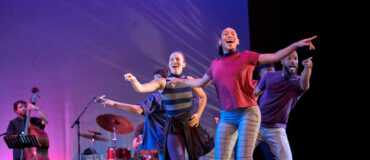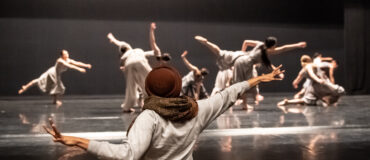By Bethany Greenho
Bethany Greenho is a 2023 Archiving and Preservation Fellow with Cleo Parker Robinson Dance. Read more about the Fellowships here. This is the third part of Bethany’s blog; read the second part here.
Southland in the Archives

“Juba/Field Dance” from Katherine Dunham’s “Southland.” Photo: David Andrews. Re-Staged by Cleo Parker Robinson Dance, September 2012, Newman Center for the Performing Arts.
While exploring the various spaces that house collection materials in the first two weeks of my Fellowship, I came across a series of boxes and folders labeled “Southland.” Despite finding other folders labeled with the titles of Cleo Parker Robinson Dance repertoire pieces, finding materials related to Southland stuck out. This was due to my early conversations with CPRD staff members which emphasized the importance of the piece to CPRD’s history. After briefly reading through some of the correspondence and programs in my initial search, the larger implications and significance of Southland to CPRD, dance history, and social justice for Black Americans became clearer. I knew then that when it was time to shift my work to inventorying the paper and photographic collection materials, I wanted to start with these Southland materials.

Five piles of archival materials related to both the 2012 CPRD premiere of “Southland” and the 2013 tour production at the University of Florida. Materials include programs, correspondence, promotional materials, travel materials, and DVDs.
My desire to start with the Southland materials for the paper and photographic inventory was two-fold. First, Southland is significant to both CPRD and dance history. Southland is a ballet choreographed by Katherine Dunham that premiered in 1951. Southland presents a story of the lynching of a Black field hand on a plantation in the antebellum South after being falsely accused of raping a white woman. Intended by Dunham to stir the consciences of audiences, Southland is a protest piece for social justice for Black Americans created four years before Emmett Till’s murder and the Montgomery Bus Boycott, events associated with sparking the national Civil Rights Movement. Yet, the day after its premiere in Santiago de Chile in 1951, Southland was deemed controversial and un-American by U.S. Embassy officials and was only performed one more time in 1953 in France.* Southland was never performed in the United States until 2012 when CPRD was given a grant from the National Endowment for the Arts to reconstruct Dunham’s seminal piece. Cleo worked with Julie Belafonte, the original portrayer of Julie Robinson in Dunham’s Southland, to resurrect the piece to be performed as part of CPRD’s 2012 spring concert and then on tour at the University of Florida in 2013.

A page containing Cleo Parker Robinson’s handwritten production, staging, and plot notes related to “Southland.”
In bringing Southland to U.S. soil, Cleo and her Ensemble not only added a signature piece to their repertoire of works created by seminal Black choreographers, but they also added their names to dance history as the group that premiered Dunham’s controversial work in the United States. Yet for CPRD the significance of Southland goes beyond the connections to Dunham and dance history. As a company built on the values of social justice and honoring and building on the work of the ancestors who came before, both the story that Southland brings to life and the history of the production itself directly reflect those values. The work that Cleo and CPRD did with Southland, therefore, can be seen as a perfect encapsulation of this company and what it stands for. In contributing my time to inventorying and organizing these materials, I was able to make Southland materials, and by proxy the stories and significance of Southland, more easily accessible for later reconstructions, for advocacy and promotion of CPRD’s archives, and for highlighting the values of CPRD.

“Strange Fruit” from Katherine Dunham’s “Southland.” Performers: Roxanne Young (CPRD) and Mary Louise Lee (Singer). Photographer: David Andrews. Re-Staged by Cleo Parker Robinson Dance, September 2012, Newman Center for the Performing Arts.
The second reason I prioritized inventorying the Southland materials was selfish: I personally wanted to look through these materials. In my initial examination, I briefly saw photocopies of photographs, scholarly articles, newspaper clippings, programs, and a variety of handwritten notes. On closer inspection, those photographs turned out to be copies of rare photos from a 1953 French production; the scholarly article was Cleo’s annotated copy of Constance Valis Hill’s well-known 1994 article “Katherine Dunham’s Southland: Protest in the Face of Repression”; and the handwritten notes varied from Cleo’s plot and choreographic notes to rehearsal corrections for the dancers to personal writings from cast members including Susan Richardson, who played Julie Robinson in CPRD’s productions, reflecting on playing a white woman who wrongly accuses a Black man of rape. Digging further into these materials, I found grant application materials that laid out how Cleo and CPRD were going to pull off this historic feat, copies of the program notes and spoken word pieces from the 1951 Santiago de Chile production with English translations, staging diagrams, and a DVD of Ensemble members rehearsing.
As intriguing as all of these materials were, a few materials particularly stood out for me. The first were the background research materials: Cleo’s annotated copy of Hill’s article, the photocopies of photos from the French production, and the program notes and script. I had previously come across materials that Cleo used as research for other repertoire pieces, but seeing her annotations was a first. In the brief time I spent examining them, I got to see inside Cleo’s head and see how she understood and wanted to approach the themes and significance of Southland. Additionally, seeing the photos from the 1953 French production not only provided a rare glimpse into an already rare piece but made me wish I had the time to compare those images to the handwritten plot notes to see if and how the emotion conveyed in the images was interpreted by Cleo as she was working on this piece. Together, these research materials created a rich picture of the work that went into reconstructing Southland, and the researcher inside me wanted to spend more time exploring and talking with Cleo about the thoughts and creative decisions that came from such materials.

“The Accusation” from Katherine Dunham’s Southland. Dancers: Devin Baker and Susan Richardson (CPRD). Photo: David Andrews. Re-Staged by Cleo Parker Robinson Dance, September 2012, Newman Center for the Performing Arts.
The other material that stood out was a manuscript written by Susan Richardson. In the manuscript, Richardson discussed her experiences and thoughts related to playing the titular character whose lie causes a Black man to be murdered. Richardon’s writing provided a dancer’s perspective on working on Southland, expanding the narrative that the archive tells about this piece. The writing also had an element of healing. This sense of healing came from Richardson’s explanation of the mental struggles she faced in playing this role and how she worked through this character. Seeing Richardson’s thoughts on paper regarding what it meant for her to play this character and how she grappled with the character’s actions spoke to the power that Southland, and dance at large, can have to evoke introspection and reflection about the world around us and ourselves in order to learn, heal, and grow.
Richardson’s writing reminded me of one of my early conversations with Cleo where she talked about wanting her archive to be a source of healing. Knowing there are records like the Southland materials within the collection brings the CPRD Archive one step closer to making that vision a reality.
*Resources
“Notes on Southland.” Library of Congress. Accessed August 28, 2023. https://memory.loc.gov/diglib/ihas/html/dunham/dunham-notes-southland.html.
Header image: photo by Jerry Metellus, courtesy of Cleo Parker Robinson Dance Ensemble.
Archival material images courtesy of the author.
 Bethany Greenho (she/her) is finishing a master’s degree in library and information science with a focus in archives and digital curation at the University of Maryland, College Park. She is interested in discovering how user-oriented access and ethical and community-centered description can become the means through which hidden or ignored stories become findable and accessible.
Bethany Greenho (she/her) is finishing a master’s degree in library and information science with a focus in archives and digital curation at the University of Maryland, College Park. She is interested in discovering how user-oriented access and ethical and community-centered description can become the means through which hidden or ignored stories become findable and accessible.
Bethany’s work with the George Balanchine Trust showed her the importance of having access to the tangible artifacts of dance as a way to preserve dance and its history beyond its ephemeral nature. In her current work with the University of Maryland Libraries Preservation Department, Bethany has seen how preservation works in concert with archives to ensure continued access to all stories.
Bethany is excited to use her background in dance and archival science at the Cleo Parker Robinson Dance Company to begin the process of organizing and preserving their collections to make them accessible to the community. Photo courtesy of Bethany Greenho.
____
We accept submissions on topics relevant to the field: advocacy, artistic issues, arts policy, community building, development, employment, engagement, touring, and other topics that deal with the business of dance. We cannot publish criticism, single-company season announcements, and single-company or single artist profiles. Additionally, we welcome feedback on articles. If you have a topic that you would like to see addressed or feedback, please contact communications@danceusa.org.
Disclaimer: Opinions expressed in guest posts do not necessarily represent the viewpoints of Dance/USA.






